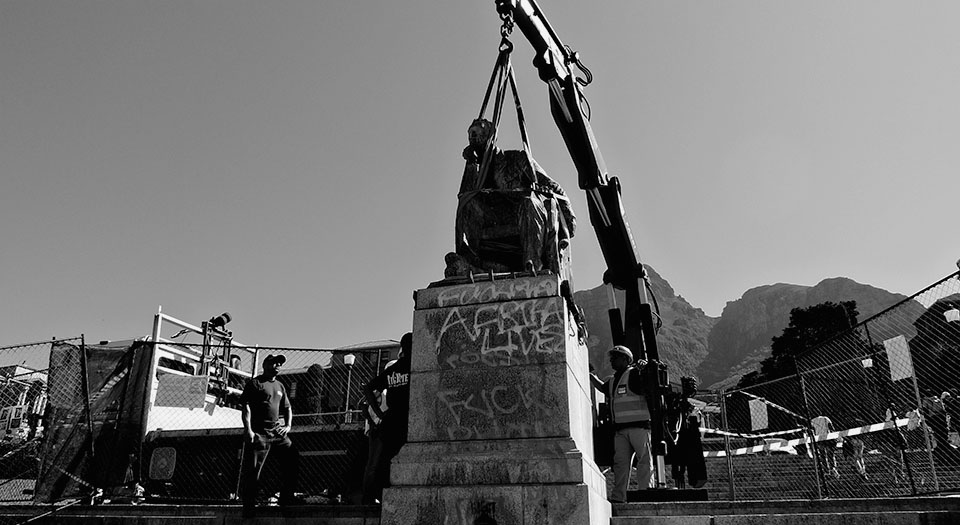The racialism of Rhodes Must Fall
Students at the University of Cape Town are demonising an entire race – white people.

At the University of Cape Town (UCT) last week, students associated with the Rhodes Must Fall (RMF) movement attacked UCT property in protest at the lack of student accommodation. They ransacked halls, set fire to paintings of white people, petrol-bombed the vice chancellor’s office, and torched a bus. ‘Whiteness is burning’, they proclaimed. Ironically, one of the paintings burnt was a 1993 oil painting depicting protests at the university. It was painted by Keresemose Richard Baholo, a black anti-Apartheid activist.
Artistic creation has long been a method of protest. Pablo Picasso’s Guernica railed against Spanish fascism; Diego Rivera’s murals reflected the struggles of the Mexican working class; Jean-Michel Basquiat’s abstractions interrogated racism in New York in the 1980s. But now protest has become more about destruction than creation. In the same way that students in the West have sought to censor ideas with which they disagree, RMF-supporting students in South Africa seek to erase anything they see as inconsistent with their ideology.
RMF’s mindless violence and its refusal to engage with the university’s ruling bodies have alienated South Africans formerly sympathetic to its aims. But its actions are not an aberration. Rather, they speak to the underpinning of contemporary identity politics: an obsession with victimhood. This obsession has turned identity politics into a vicious cycle of self-oppression. These students have allowed themselves to be offended – to be victimised – by inanimate objects to the point where they feel they have to destroy them. This is the form that contemporary illiberalism takes: in their unquestioned certainty, these students refuse to tolerate the slightest degree of objectionable symbolism. Removing the statue of Cecil Rhodes was not enough – now no white symbol is safe from their quest for ‘decolonisation’.
RMF has blamed the housing crisis on the supposed institutional racism of UCT, a stance which was implicitly encouraged by the ANC government to distract from its own failure to provide funds for new housing and accommodation. Indeed, in many provinces, the ANC presides over failing state-education systems, many of which are essentially controlled by corrupt teachers’ unions. The legacy of Apartheid has been perpetuated by a broken government. Last year, the World Economic Forum ranked South Africa 138 out of 140 countries in the teaching of maths and science. But instead of shouting about these disgraces, these protesters are fixated on the artwork adorning university walls.
UCT, and South Africa more broadly, is not the only racialised student battleground. The same ideas can be seen at the University of Oxford, where students have argued that the removal of the Rhodes statue at Oriel College will somehow help to tackle the ‘institutional racism’ that has led to a disproportionately low percentage of black students being admitted. This cultish obsession with symbols and statues tragically distracts from real issues of racial inequality.
In this age of identity politics, we are now told not to judge people by the content of their individual character, but by the colour of their skin. We are encouraged to define people by their genetic characteristics, to see them primarily as racial beings. We must assume that every black person is a victim of systematic racism, and that every white person is born with a silver spoon in his or her mouth. Suggesting that racism is rather more complicated than identity-politics advocates suggest, or refusing to judge someone on the colour of their skin, is heresy.
Astonishingly, even Nelson Mandela’s idea of a multiracial ‘Rainbow Nation’ has been labelled ‘oppressive’ by UCT’s student magazine, because it supposedly ignores racial differences. Just to add to the absurdity, and despite agreeing with the magazine’s arguments, RMF members have in turn slammed the student magazine and its white writers for ‘appropriating’ their struggle. RMF activists, you see, insist on the absolute racial purity of their struggle.
The same night as paintings and buses were set alight, the words ‘fuck white people’ were daubed on the plinth where the Rhodes statue had stood. These nasty ideas of collective and historical guilt are irrational and counterproductive. Racism still exists in South Africa and the damage of Apartheid is still very real. But that is not the fault of every white person. In the same way black people should not be asked to speak on behalf of their race, or all Muslims apologise for the actions of Islamist terrorists, so all white people should not be figuratively burnt on the pyre of ‘decolonisation’ on university campuses. It doesn’t matter who it’s being done to – blacks, whites, Muslims or Jews – homogenising and demonising an entire group is always dangerous.
It’s also extremely ugly. In Cape Town, these students study and live in buildings built by European colonists. Let’s hope they don’t burn down their university as well.
Joe Arthur is a former spiked intern.
Picture by Desmond Bowles.
To enquire about republishing spiked’s content, a right to reply or to request a correction, please contact the managing editor, Viv Regan.








Comments
Want to join the conversation?
Only spiked supporters and patrons, who donate regularly to us, can comment on our articles.